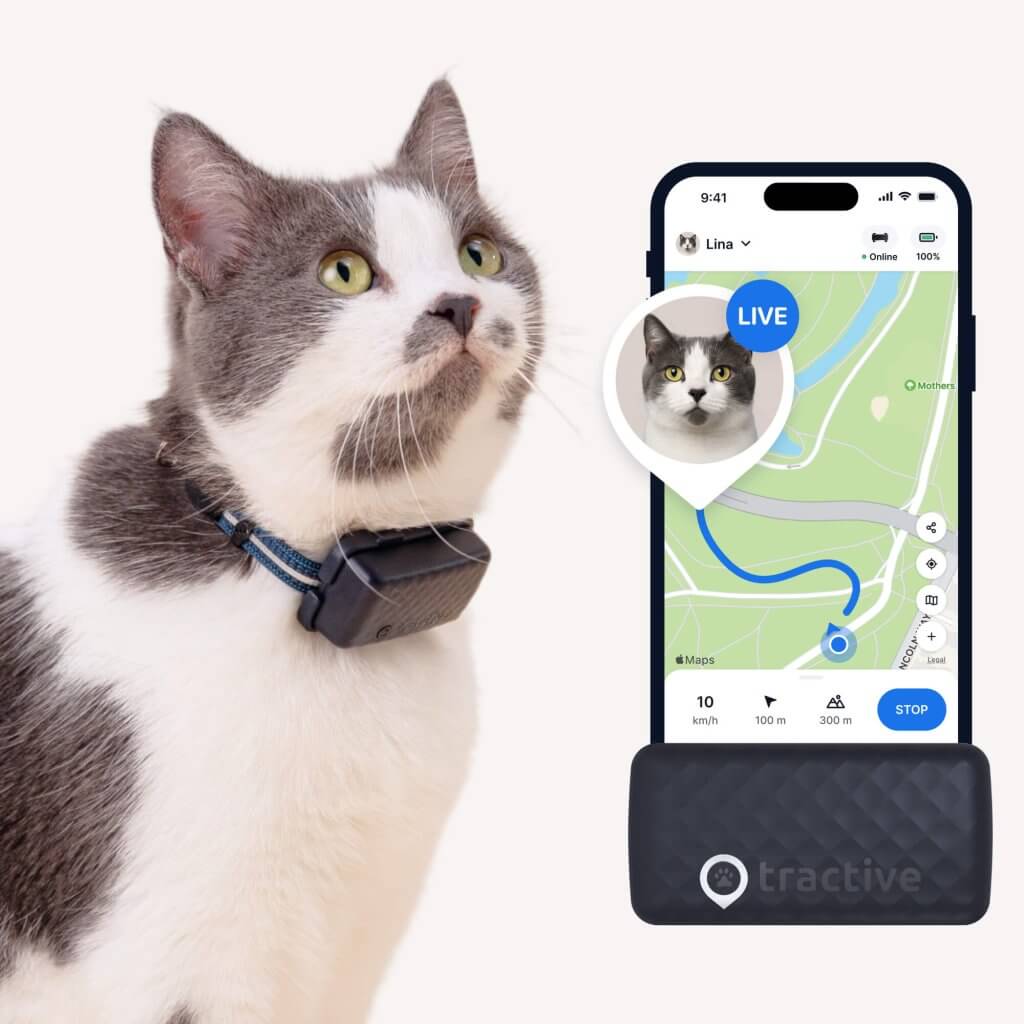How To Find A Lost Cat (What To Do If Your Cat Is Missing)
Has your cat gone missing and you don't know what to do? Don't panic. Use these tips to find your lost cat fast.
Realizing your cat is missing can be a gut-wrenching experience. In this guide, we’ll walk you through exactly what to do if your cat goes missing – with expert (and some unconventional) tips on how to find a lost cat.
Key Takeaways: What to do if your cat goes missing
- Stay calm & act fast.
Don’t panic – begin your search immediately and stay proactive. - Search thoroughly & nearby.
Most missing cats are found close to home. Look in hiding spots like garages, sheds, and under decks. - Alert others.
Inform neighbors, post on community platforms, and put up flyers with recent photos. - Use scent & familiarity.
Leave out their bedding, litter box, or favorite food to help them find their way back. - Leverage technology.
A GPS cat tracker like Tractive can be a lifesaver, helping you locate your pet in real time. - Don’t give up.
Cats can return after days – or even weeks – missing. Keep checking in with local shelters and following up on sightings.

Find out where your cat spends their time.
Read more- How likely is it to find a lost cat?
- How long do cats go missing for?
- Why do cats run away?
- How to find a lost cat with a microchip
- How to find a lost cat inside the house
- How to find a lost cat outside
- How to find a lost indoor cat
- How to find a lost outdoor cat
- How to find a lost cat with a Tractive GPS cat tracker
- How to lure a lost cat out of hiding
- Missing cat poster: A helpful template you could use
- Contact local vets and shelters
- Ask local animals
- More tips on how to find a lost cat
- How to stop a cat from running away
How likely is it to find a lost cat?
If your cat is currently missing, you’re probably wondering: what are the chances of finding a lost cat? Luckily, a 2018 study from Animals has some answers. In their study:
- 61% of lost cats were found within one year
- 34% of lost cats were found (alive, thank goodness) within 7 days
- 75% of cats were found within 500 meters of where they escaped
- A physical search increased the likelihood of finding a missing cat
- after 90 days, lost cats were less likely to be found alive 😿
💡 Tip: The faster you can get outside and go search for your missing cat, the higher your chances of finding them.
How long do cats go missing for?
Most cats don’t go missing for very long – though it often depends on why they’re missing in the first place. Even if they stay out longer than usual from time to time, they’ll usually come home when they’re hungry. However in some cases, cats can go missing for days, weeks, months or even years. The sooner you get started with your search, the more likely you are to find them again, safe and sound.
⚠️ If your cat is gone for more than 12 hours or overnight, it’s time to take action.
Why do cats run away?
Cats run away for a whole bunch of reasons, which might include their reproductive status, hunting/territorial instincts, or just getting lost. An unspayed female cat or un-neutered male cat might have a strong mating instinct that drives them to roam. All cats are territorial and might have wandered off to expand their territory or go hunting. Or if your indoor cat isn’t used to the outdoors, they could find it difficult to make their way back home. Narrowing down these reasons can help you take steps to prevent your cat from escaping the next time.
How to find a lost cat with a microchip
If your cat has a microchip, you’ll need to wait until someone finds them and brings them in to a shelter or vet where the microchip ID can be read. If your contact details on the microchip ID are up to date, and if you’re lucky enough to get a call about your missing cat, you’ll be reunited.
Just remember: while a microchip is a security must-have, it does not actively help you search for a lost cat or guarantee that they will be returned to you. It only ensures that your cat isn’t mistaken for a stray and that you can prove you’re their owner. You’ll still have to rely on the goodwill of strangers and depend on them to get in touch with you.
Unlike a microchip, a GPS cat tracker helps you find your lost cat in minutes by letting you follow their location in real-time.

Track your cat wherever they go
See where they are in real-time, no matter how far they roam. Discover their territory. Get alerted if they go too far. Track activity, sleep, and receive health alerts if your cat’s activity changes. Keep your feline friend healthy and safe.
How to find a lost cat inside the house
Begin your search within a 10-foot radius of where you last saw your cat. If a cat is spooked, they usually run to the nearest safe, enclosed space. Close all bedroom and closet doors if you can, so your cat doesn’t relocate to a newly searched area. Check all the unusual spot – especially places that offer a feeling of being fully enclosed, like:
- Under beds, sofas, and large pieces of furniture.
- Inside box springs (check for tears in the fabric).
- On top of kitchen cabinets, refrigerators, or high shelves.
- Inside closets, dressers, and under piles of clothes.
- Behind appliances (washer/dryer, oven) and water heaters.
- Inside open bags, backpacks, or cardboard boxes.
- Behind books on a bookshelf (they squeeze into gaps).
- Vents and chimneys, which are less common, but check if any vent covers are loose.
Do thorough check indoors, and ask other members of the household to help. If you have a Tractive GPS cat tracker, use Radar Mode (great for close range or indoors) to find your hiding cat indoors. Else, you could trigger an LED light or a high-pitched melody from their tracker to guide you to them.
How to find a lost cat outside
After searching in the house, do a thorough check of your property or your immediate surroundings. Check places they could be stuck or hiding, including:
- Under the deck or porch
- On the roof
- In the garage
- Up a tree
- Inside the car
- In a chimney
- Around the trash and recycling bins
According to pet detective and lost cat expert Kat Albrecht, missing cats tend to hide, in silence, typically staying close to home.1 That means your lost feline friend is probably closer than you think. They might have gone into hiding, outside and close to home, for any of the reasons above. Or they might have gotten stuck, lost or frightened while chasing butterflies. If your cat is an indoor cat, it’s more likely you’ll find them near home.
How to find a lost indoor cat
Start searching your immediate surroundings in order to find a lost indoor cat. Call their name, put out some cat food, and check any potential hiding spots like in the garage or up a tree – and your feline friend will likely be back in your arms in no time. Remember: cats are territorial creatures and don’t leave their territory without good reason. And thankfully, indoor cats usually have a much smaller territory than outdoor cats. This means they only feel comfortable exploring their “home territory”, so they probably won’t travel much further than a small distance from where they live.
In fact, a 2017 study found that missing indoor cats were found, on average, a distance of only 39 meters (128 feet) away from home. Outdoor cats, on the other hand, are known to travel farther. They were found an average distance of 300 meters – or three football fields – away.
How to find a lost outdoor cat
Start at home and work outwards. (Remember, 75% of cats were found within 500 meters of where they call home.) Call for your cat by name. They can recognize your voice as well as their own name, even when strangers call it.2 The sooner you start looking for your lost cat, the easier it will be to find them. It’s also a good idea to ask friends and neighbors to help you actively search. If they can’t, ask them to call or text you if they see your cat.
If your cat is missing and nowhere to be found inside or near your home, don’t just wait for your cat to return home on their own. A study by pet detective Kat Albrecht and professor Jacquie Rand found that 59% of lost cats were found alive precisely because their humans actively searched for them.3
Finally, consider what might’ve made your cat run away. Could they be searching for a mate? Or have you moved recently? (Your cat might be trying to visit their old territory.) Or is your cat likely to be hiding or exploring a neighboring farm? Their personality and habits can help you narrow down the reasons behind their disappearance.
How to find a lost cat with a Tractive GPS cat tracker
If your lost cat is wearing a Tractive GPS cat tracker, you’re in luck! This will make your search for your missing cat much easier. You can:
- Hit LIVE to follow every step in the Tractive GPS mobile or web app with real-time location updates every 2-3 seconds
- Track together with friends and family using Family Sharing
- Use Radar Mode once you’re nearby to pinpoint their location – they might be hidden behind or under something
- Activate light or sound if it’s dark out, or hard to see where they are
- Share your cat’s current location with the public if they’re further away, and you need help getting reunited. You can do this in the location section under the Tracker tab in your profile.
From the Tractive app, you can also set up “safe zones” and get an escape alert if your cat sneaks past it. So you’ll be able to intercept an escape attempt that much quicker.


How to lure a lost cat out of hiding
Put a bowl of your cat’s favorite treats or food outside your doorstep. You could even put food in additional spots around your home if you have a large outdoor space. Your cat might catch the smell and run home for a tasty snack. Special “smelly” foods like tuna and sardines work great as well. Heat them up to increase the aroma, but avoid salt and oils. Just be mindful that this might also attract other wildlife, including raccoons.
Else, you could also leave the garage, or another door cracked open – cats like to sneak inside. Put your cat’s favorite bed, blanket or scratcher outside so that the scent attracts them. Make sure someone is there to spot your cat in case they come home for a bite to eat. This can help lure your missing cat home.
Finally, you could also go outside, and talk in your normal voice, as if you’re chatting on the phone – cats are known to be attracted to their human’s voice. And keep an eye out: cat parents have reported their cats returning most often between the hours of 8pm-2am and 4am-7am.4
Missing cat poster: A helpful template you could use
Still no luck finding your cat after your search? It might be time to put up missing cat posters. An effective lost cat sign should include:
- A high-resolution photo of your cat
- A physical description including age, sex, coat length and color, and any other special markers (like a unique fur pattern, or a colorful collar) that could be used to identify your cat
- When and where your cat was last seen
- Your name and phone number
When putting up the cat posters, remember: cats go farther than we sometimes think. Hang posters at public transport stops to make sure as many people see your poster as possible. Cover the posters in plastic or tape for durability.
Click on the link below to download the free lost cat poster template from Tractive:

You’ll also want to post your cat’s picture and description on various social networks. Ask your friends to keep an eye out. On most social media platforms, there are specific groups or lists for lost & found animals in specific regions. Check the pages of animal shelters in your area; they’ll often post their latest finds online.
Contact local vets and shelters
Call your local vets and animal shelters to ask if anyone has brought in a cat matching your cat’s description. Leave them your number, so that they can call you in case your cat is eventually brought in. Also check shelter websites – people often post missing cats they’ve found here. You might find these regional resources useful in your search to being reunited with your lost cat:
- Missing Animal Response Network – Lost Pet Recovery Training by Kat Albrecht
- Animal Search UK
Ask local animals
If you want to find a lost cat, here’s an unusual tip from some fellow cat lovers in Japan. If you see other cats in your neighborhood, talk to them! That’s right – enlist the help of other felines in the effort to bring your cat home. According to an article on Japan Today, some lost cat parents have had success by doing the following:
When you see other cats in your neighborhood, approach them kindly. Tell them, if they happen to see your cat, to tell your cat to come home. It might sound strange, but if it can help you find a lost cat – why not give it a try?
Will my other cat look for my missing cat?
Some people wonder if their other cats will look for and maybe help them find the missing cat in their family. Eva Morchairs shared a success story like this on Quora:
“Tofu (the cat) didn’t come home after being let outside to play. I stayed up all night worrying about her. Come morning, still no sign of her. I had another cat, Fifi, that wanted to go outside and play. Before I let her go outside I picked her up and held her face up to mine and made eye contact with her and asked her to go and find Tofu. I told her to go find her and bring her home. I gave her a small kiss on the nose and I opened the back door for her and let her go play. About twenty minutes later my mom called out to me – Fifi and Tofu were both sitting on the steps outside my back door.”
So, it seems like it’s worth a shot. You could try asking your other cats to help you find the missing one. But of course, this may not work, as the companion cats may not be willing to explore unfamiliar places in search of the lost one, in favor of their familiar territory.
More tips on how to find a lost cat
Look when it’s dark and quiet outside. Don’t bring other animals with you when you’re on your search – they may scare your cat away. Use a flashlight to search in the dark and continue calmly calling their name. Walk slowly and take frequent breaks from calling out, so that your cat has a chance to call back. Check places where your cat could get stuck or retreat into to find warmth. You could also sprinkle some flour around and check for paw prints, if you suspect your cat is hanging around but not coming home.
Another option is to set up a humane baited trap (available at a feed or hardware store). Place some kitty litter or clothing and towels with your scent on them to lure your lost cat in. Else, try installing motion sensor cameras or baby monitors around your house.
If it’s been a while since they’ve gone missing, you could hire a lost cat finder or pet detective. Offer a reward to anyone who can find your cat. Ask anyone who visited your property (such as a delivery person) to check their van or truck.
Finally, our last tip on how to find a lost cat: Don’t give up!
How to stop a cat from running away
Hopefully, you’ve found your cat with the help of these tips. Now, what can you do to prevent your cat from running away and going missing again?
- Track your cat in real-time with a GPS cat tracker – and get alerted if they leave a safe area
- Create a cat enclosure
- Do anything you can to keep your cat happy and occupied at home.
- Spay or neuter your cats
Remember, should your cat go missing, the most important thing is to not give up. Finding a lost cat might feel challenging, but chances are, you will be reunited in no time. The good news is that studies have shown that about 74% of lost cats are eventually united with their family again5. So try to stay calm and hopeful until your feline friend is in your arms again.




